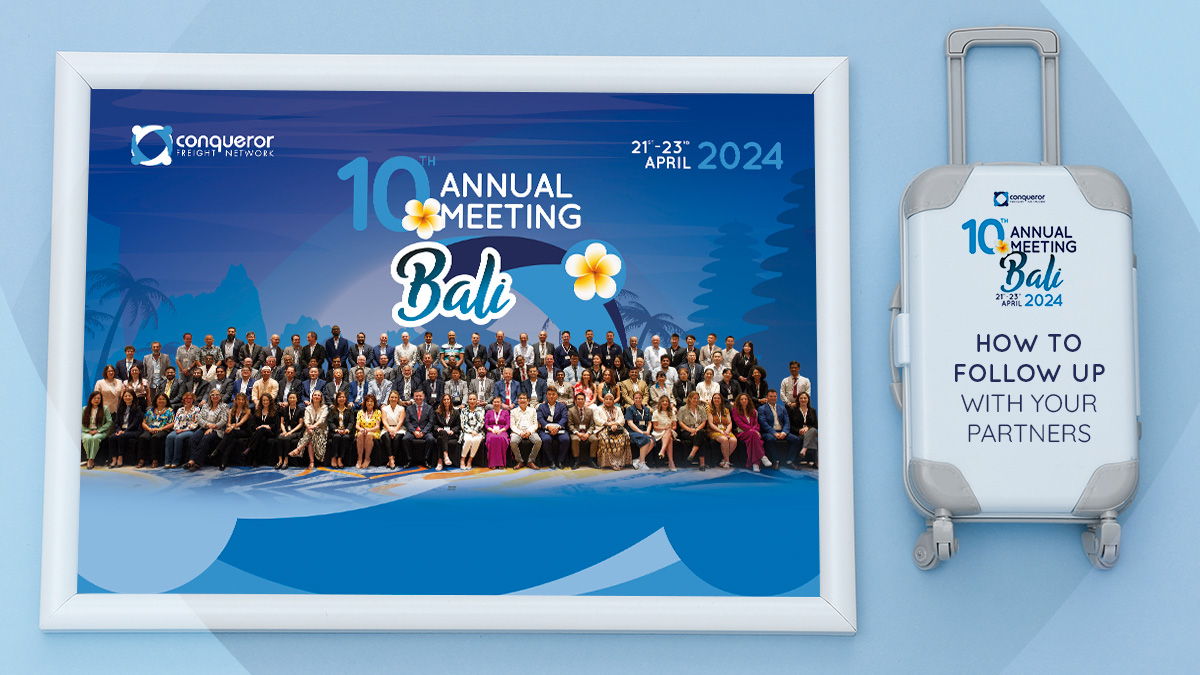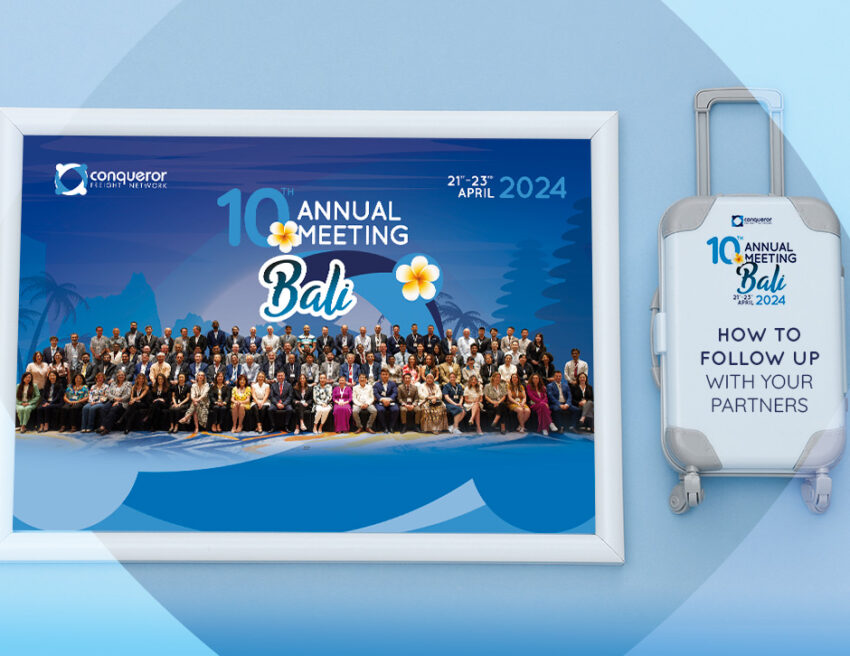The 10th edition of Conqueror’s Annual Meeting, one of the best freight forwarders conference which brought together 120 forwarders from across the globe in Bali, has concluded with much success. With the conference behind us, it’s now imperative to chart a robust follow-up plan to propel forthcoming projects forward. Holding personalized discussions with your business allies is absolutely vital for expanding your operations. Yet, to truly capitalize on the momentum of our Annual Meeting and nurture enduring partnerships, dedicating time post-event is indispensable. Taking a proactive stance towards collaboration and relationship cultivation is paramount; relying solely on partners to initiate isn’t advisable. This is precisely where a well-structured meeting follow-up strategy proves invaluable. In this blog, we’ll delve into various tactics to enrich networking endeavors following the freight forwarders conference in Bali.

Tips to make the most of a freight forwarders conference
Participating in a freight forwarders conference can be one of the best ways for independent freight forwarders to get new projects and globalize their operations. The chance to network with reliable agents, gain insights from sessions, and stay updated on industry trends makes for a rewarding experience. Yet, the true value often lies in what happens after the conference wraps up. Skillful follow-up is key to extracting the most from your attendance, transforming fleeting connections into enduring business partnerships. Dive into the following tips to refine your post-conference follow-up game and drive your business to new heights.
-
Connect with your partners within 2 days of the meeting
Getting in touch promptly after a meeting is key to leaving a strong impression on your partners. This ensures that your company stays top-of-mind when they’re making decisions about service providers. It’s best to reach out within two days of the meeting, ideally on the same day. Sending a concise thank-you email summarizing the main action items is highly recommended. You can also take this chance to resolve any misunderstandings or answer questions about the project. Clear communication at this early stage helps set a positive tone for future collaboration.
-
Send a follow-up email
When it comes to reconnecting with partners after an event, sending a follow-up email is often the most effective approach. However, it’s essential to avoid the trap of sending generic emails to all your new connections. Personalization is the secret ingredient that demonstrates genuine interest and sets you apart. Tailor your email to convey why you’re excited about the partnership and emphasize how you can bring value to the project. Your recipient should feel your sincerity and enthusiasm, recognizing your dedication to the upcoming partnership.
-
Take your follow-up endeavour beyond email
Expanding your follow-up efforts beyond email is key to maximizing engagement with your contacts. Don’t limit yourself to one communication channel; instead, leverage a variety of platforms such as Facebook, Twitter, or even direct phone calls to reconnect with your partners. Understand that different individuals have varying preferences when it comes to communication, so by diversifying your approach, you increase the likelihood of reaching and engaging your contacts effectively.
While email serves as the primary method of communication initially, it’s important to be flexible and adapt to the needs of each partner. For urgent matters or when a more personal touch is warranted, consider scheduling a phone or video call. These direct interactions can help strengthen relationships and address any pressing issues more efficiently.
Moreover, don’t underestimate the power of social media in maintaining connections. Following your partners’ accounts and engaging with their content can help foster rapport and keep you top-of-mind. Additionally, platforms like LinkedIn offer opportunities to share relevant industry insights and stay connected in a professional context.
-
Do not send a marketing pitch in the email
Avoid making your email sound like a sales pitch for your company. Respect your partners’ time by keeping your message short and to the point. Trim unnecessary introductions, repetitions, and excessive details. Remember, the shorter your email, the more likely your partner will take it seriously and respond promptly.
-
Try to respond quickly to your partners’ queries
An essential aspect of an efficient meeting follow-up strategy is ensuring prompt responses. It’s not only about reaching out to your partners; it’s equally vital to promptly address any inquiries and quote-related emails from them. With Conqueror’s TMS FreightViewer, you can instantly generate online quotes for your partners, eliminating the need to wait for hours or even days to receive a quotation. This streamlined process saves time for both parties and enhances the overall efficiency of your communication and collaboration.
-
Try to provide invaluable solutions
Keep in mind that your follow-up strategy shouldn’t solely revolve around maximizing ROI. While that’s undeniably important, the primary objective of your post-meeting follow-up should be to bolster your enterprise’s reputation. To achieve this, focus on providing valuable insights and potential solutions relevant to the discussed project.
Moreover, consider introducing your partner to trusted peers who can offer assistance with specific aspects of the project. This collaborative approach not only strengthens your relationship but also demonstrates your commitment to mutual success.
By prioritizing value creation and collaboration over immediate returns, you not only enhance your reputation but also foster a culture of trust and cooperation within your professional network. This, in turn, can lead to more meaningful and sustainable partnerships in the long run.
-
Do not put pressure on your partners
Respectfully, pressuring your partners into quick decisions isn’t conducive to successful follow-up. Acknowledge that their choices are driven by their own interests, and they don’t owe you anything. Effective follow-up is a gradual journey that requires patience and persistence. When concluding your interactions, suggest a suitable time for the next follow-up, giving them the space to deliberate on their options.
Bombarding partners with numerous emails and calls is counterproductive and may deter them. It’s more effective to wait for their response before crafting a thoughtful follow-up message. Ultimately, your approach should prioritize mutual respect and consideration for your partners’ time and preferences. This approach not only strengthens your relationship but also fosters a more conducive environment for collaboration and decision-making.


